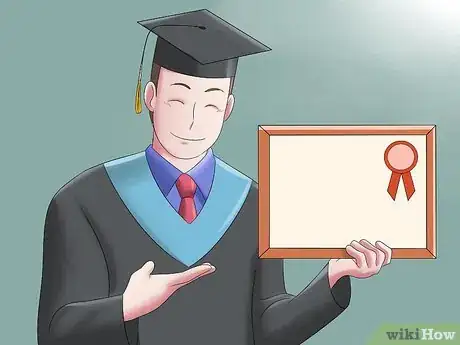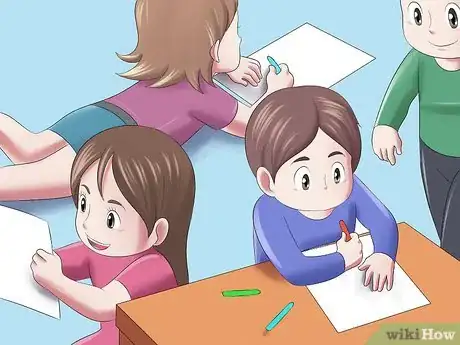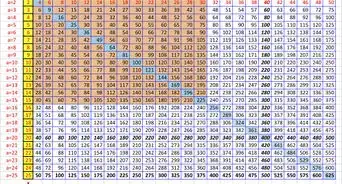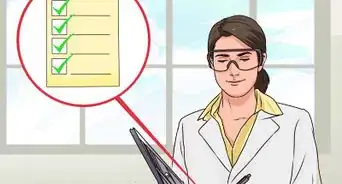wikiHow is a “wiki,” similar to Wikipedia, which means that many of our articles are co-written by multiple authors. To create this article, 13 people, some anonymous, worked to edit and improve it over time.
There are 10 references cited in this article, which can be found at the bottom of the page.
wikiHow marks an article as reader-approved once it receives enough positive feedback. In this case, 92% of readers who voted found the article helpful, earning it our reader-approved status.
This article has been viewed 241,653 times.
Learn more...
Montessori, a teaching style developed by the Italian physician and teacher Dr. Maria Montessori, offers a very different experience for both the student and the teacher when compared to a traditional education. However, like traditional teachers, Montessori teachers still must become certified to be able to bill themselves as genuine Montessori professionals. Not counting an undergraduate education, the training for a Montessori teacher can involve a year of study followed by an additional supervised practicum to become fully certified. To start down the path to your first Montessori job, see Step 1 below!
Steps
Becoming Certified
-
1Complete a college education for the greatest range of opportunities. For aspiring Montessori teachers, a college education is a very smart idea. Though not every single Montessori-related job will require a college education, many states in the U.S. (and many countries outside the U.S.) have this as a requirement for Montessori teachers. In addition, the lack of a college degree may, in certain situations, qualify you only to become certified only for assistant-level positions. For these reasons, a college degree can greatly expand the range of Montessori opportunities available to you.[1]
- Luckily, Montessori teachers-in-training usually aren't required to have majored in education or a related field in college. Many successful Montessori teachers originally studied in fields as diverse as law, engineering, or the humanities.
-
2Pick an accredited training center. Montessori certification training is a serious investment — though it will give you valuable skills and credentials, it can cost thousands of dollars and require a year or more to complete. Because of this, it's very, very important to be sure that the training center you enroll at is fully accredited by a recognized Montessori accreditation agency. Most legitimate training centers will be more than happy to disclose their accreditation status with you. If the training center you're thinking of enrolling in lacks the proper credentials, do not enroll — this can be a huge waste of your time and money.[2]
- Luckily, Association Montessori Internationale (AMI), the global Montessori association, has a directory of certified training centers available on its website. In addition, The Montessori Foundation has a more extensive list of training locations.
- Additionally, the American Montessori Society offers a free online training center locator.
- Note that, in the United States, accreditation from the Montessori Accreditation Council for Teacher Education (MACTE) is generally seen as the definitive sign of a training program's legitimacy.[3]
Advertisement -
3Choose an area of certification. Contrary to popular belief, Montessori isn't just a style of teaching for preschool-aged children. In fact, it's a versatile teaching method that's used for children up to (and, in rare instances, through) their teenage years. While the foundational principles of Montessori teaching are the same for all Montessori classrooms, the techniques and skills used to teach different ages of children can vary substantially, so, in general, most people who want to become a Montessori teacher need to specialize in one or more educational age ranges. The most commonly-offered areas of certification are:[4]
- Infant & Toddler: (0 - 3 years)
- Early Childhood: (2.5 - 6 years)
- Elementary I (6 - 9 years)
- Elementary II (9 - 12 years)
- Elementary I & II (6 - 12 years)
- Montessori administration
- Note that some special programs offer skills for teaching children up to age 18.
-
4Enroll in a training program. When you've located a fully accredited training center near you, you'll want to enroll in the next available training session. The precise start and end dates of your training period will vary based on your training agency — for instance some courses run year-round, while others take place over one, two, or more summers.[5] Pick a training schedule that accommodates your goals and needs.
- Montessori training programs vary in price, but, in general, you should expect to spend at least several thousand dollars. For instance, some relatively low-cost Infant/Toddler training programs run at about $2,000 in total.[6]
-
5Complete your coursework. Though training programs can vary, in general, people training to become Montessori teachers attend classroom lectures, complete written coursework, and practice hands-on training. The mixture of abstract and practical work offered by most Montessori programs is designed to produce a graduate who is comfortable and experienced working in a Montessori classroom setting and who understands the principles of Montessori teaching well enough to adapt to any situation. In general, Montessori teachers-in-training should expect to:
- Complete approximately 1,200 hours of instruction in total.
- Demonstrate an ability to create Montessori teaching materials for all subjects.
- Participate in approximately 90 hours of classroom observations and supervised teaching.
- Complete an on-site teaching practicum.
Finding a Job
-
1Find a Montessori classroom near you. Congratulations! You've completed your Montessori training and you're now fully certified to lead a Montessori classroom. Many Montessori teachers get their first job from connections they make during their on-site training and practicum. However, if you don't, this is OK — except in some cases (like for certifications earned through distance learning), Montessori credentials are transferable, marketable skills. Generally, people who have just received their Montessori credentials will want to apply for jobs at local schools with open positions for teaching children of the age range(s) for which they are certified to teach.[7]
- While you can simply contact local schools directly to check for job openings, an even easier way to find open positions is to use an online Montessori job finder! For instance, the American Montessori Society's online job search utility allows you to quickly find Montessori openings in your local area.
-
2Apply for multiple positions. As you would do when searching for any other job, you'll generally want to apply for multiple positions when you're looking to become a Montessori teacher. In some situations, you may be in competition with other Montessori teachers for the opening, and since you've presumably just become certified, you may have less teaching experience than some of the other candidates, so applying to a range of positions gives you the best possible chance of eventually getting a job.
- Note that, in the U.S., public schools generally pay their teachers higher salaries than private schools. However, for some teachers, private schools offer a freer, easier teaching environment with none of the bureaucracy of the public school system.
-
3Demonstrate your commitment to Montessori values. As with most other jobs, prospective Montessori teachers generally go through an interview/vetting process before being hired. You may be required to provide a resume, proof of your certification, and/or personal references (for these, the teachers with whom you completed your practicum are great choices). As you're being considered for the job, you'll want to show your potential employer that you fully understand the principles of Montessori teaching and that you're able to put them in to action in a classroom setting. Below are just a few things you may want to be prepared to talk about:[8]
- The main principles of Montessori education (see section below)
- Your plan for organizing your classroom and coursework
- Unique teaching materials and opportunities you developed during your practicum
- Instances when you worked to help a slow-learning child progress during your practicum
- Your commitment to your students, the public, and your profession (a teacher's three main commitments in the Montessori code of ethics)[9]
-
4Be negotiable in terms of your job opportunities. As a first-time teacher, it's a possibility that you won't get your ideal teaching position immediately. This is OK — like any other job, the profession of teaching values experience and seniority. As you teach in positions that may not necessarily be ideal to you, you'll gain valuable skills and experience that, in addition to making you a better teacher, will also make you a more attractive job candidate in the future. Stick with it — when it comes to getting your preferred jobs, more experience is always a good thing.[10]
Teaching According to Montessori Principles
-
1Give your children freedom. Unlike traditional classrooms, Montessori classrooms are largely student-led. In other words, students have a great deal of freedom in choosing when and how they complete their assignments (and, in some cases, even which assignments they complete). This principle is fundamental to the Montessori style of teaching. Children who lead their own educational experience learn independence and are more motivated to learn because of the freedoms they're given.[11]
- For instance, in Montessori classroom, it's not uncommon for the teacher to act as a "guide", rather than an instructor. She guides the children to their hands-on activities (and sits down and helps them if needed), but she allows them to interact freely with their environment. She doesn't force them to sit in rows of desks and complete assignments according to rigid rules.
-
2Allow your children to learn by doing. Montessori classrooms are much more hands-on than traditional classrooms. While some Montessori coursework may involve writing, spelling, drawing, and other activities that are done at a desk or table with pencil and paper, Montessori teachers look for opportunities for students to learn by manipulating hands-on objects like blocks, beads, and specially-designed Montessori teaching materials. Montessori educators understand that children (especially young children) don't learn best by sitting and listening to lectures — they learn by teaching themselves and each others as they interact with their environment.[12]
- For example, while a traditional classroom may teach the concept of addition by rote math drills, Montessori classrooms may use hands-on materials like abacus-style "grids" of sliding beads to teach the same concept.
-
3Allow free movement in the classroom. In Montessori classrooms, children are largely free to come and go as they please. While there may be some periods of quiet, organized instruction, most of the time, children are allowed to move throughout the classroom from activity to activity. The classroom is designed to be accessible to the children — for instance, in a Montessori preschool classroom, teaching materials will usually be arranged on low, open shelves and the chairs, tables and work stations will all be appropriately sized for young children.[13]
-
4Give children uninterrupted learning opportunities. While Montessori teachers are always available to offer their help to children who need them, often, they make an effort to step back and monitor the children as they learn, stepping in only as needed. Montessori teachers give their students opportunities to interact with their educational materials and each other with a minimum of interruption for hours at a time. This approach allows children to learn at their own pace without the interference of a rigidly structured schedule, which, for many children, can present unnecessary barriers to learning.
- For example, in a Montessori classroom, the teacher may instruct her children that, by the end of the day, they need to complete and turn in three specific educational tasks. During the day, the teacher will walk through the classroom, interacting with the children, monitoring their behavior, and offering help to those who need it, but she won't assign specific time deadlines for them to complete their various tasks.
-
5Encourage mixed-age interactions. One important hallmark of Montessori education is that classrooms can include children of varying ages. With this approach, the older, more experienced children are encouraged to teach the younger ones, which benefits both students — the young children receive instruction from their peers and the older children demonstrate mastery of the coursework by teaching it themselves. In addition, children taught in a mixed-age environment gradually become more patient and comfortable interacting with others of varying learning ability.
Community Q&A
-
QuestionWhat kind of degree do I need to become a Montessori teacher?You need a master's degree in the field of education. There are a lot of colleges with degree programs that will satisfy this requirement.
Warnings
- Avoid distance education. Montessori organizations have received complaints from Montessori schools after hiring graduates from online programs, and they no longer recommend that students receive training from an online-only program.⧼thumbs_response⧽
References
- ↑ https://www.montessori.org/becoming-a-montessori-teacher/
- ↑ https://amshq.org/Educators/Montessori-Careers/Become-a-Montessori-Educator
- ↑ https://www.macte.org/
- ↑ https://amshq.org/Educators/Montessori-Careers/Become-a-Montessori-Educator
- ↑ https://amshq.org/Educators/Montessori-Careers/Become-a-Montessori-Educator
- ↑ http://www.montessoritraining.net/infant_toddler/price_lists/us_prices.htm
- ↑ https://www.montessori.org/becoming-a-montessori-teacher/
- ↑ http://www.readyprepinterview.com/jobseeker/elementary-school-teacher/montessori-teacher
- ↑ https://amshq.org/Educators/Membership/School-Membership/Member-Code-of-Ethics
- ↑ https://aimmontessoriteachertraining.org/top-5-reasons-to-become-a-montessori-teacher/
- ↑ https://austinchildrensacademy.org/the-montessori-teacher/montessori-trained-teacher/
- ↑ https://austinchildrensacademy.org/the-montessori-teacher/montessori-trained-teacher/
- ↑ https://austinchildrensacademy.org/the-montessori-teacher/montessori-trained-teacher/
- http://www.montessori.edu/info.html
- http://amshq.org/Teacher-Resources/Find-a-Teacher-Education-Program
About This Article
To become a Montessori teacher, start by enrolling at a fully accredited Montessori training center. Next, choose an area of certification and select a training program and schedule that accommodates your goals and needs. Then, complete about 1,200 hours of instruction, 90 hours of classroom observations and supervised teaching, and an on-site teaching practicum to earn your certification. Finally, start applying for teaching positions at Montessori schools near you! To learn more about Montessori values, read on!












































































